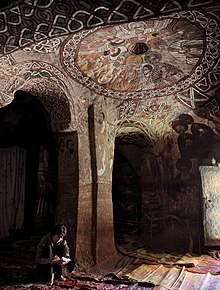Benutzer:Anno2022/Abuna Yemata Guh
Abuna Yemata Guh ist eine Monolithische Kirche in der Region Tigray in Äthiopien. Die Kirche liegt auf ca. 2580 Höhenmetern[1] und kann nur auf einem steilen Fußweg erklommen werden. Sie ist bekannt für ihre außergewöhnliche Lage, Architektur und ihre Entstehungsgeschichte im sechsten Jahrhundert [2] sowie die Wandmalereien aus dem 15. Jahrhundert.[3]
Lage der Kirche
[Bearbeiten | Quelltext bearbeiten]The church is one of the "35-odd rock-hewn churches [comprising] the largest concentration anywhere in Ethiopia."[4] Die Kirche befindet sich im Verwaltungsbezirk Woreda. Der Eingang kann nur über einen steilen und gefährlichen Aufstieg erreicht werden. Dabei ist der Weg kaum ausgebaut und bietet wenig Halt für die Aufsteigenden.[5] Visitors have to cross a natural stone bridge with a sheer drop of approximately on either side, and thereafter a final narrow wooden footbridge.[6] The standing pillars are made up of Enticho and Adigrat Sandstones, which are the last erosional remnants of a sandstone formation that once covered the Precambrian basement.[7] Although Abuna Yemata Guh is the most inaccessible place of worship in the world, priests have not recorded deaths from the climb.[8] Der Aufstieg ist äußerst steil und dauert etwa 45 Minuten. [9]
Entstehung
[Bearbeiten | Quelltext bearbeiten]According to a local legend, the church was hewn during the sixth century, and dedicated to Abuna Yemata (also referred to as Abba Yem'ata), one of the Nine Saints. The Nine Saints are traditionally believed to have originated from Rome, Constantinople, and Syria between the end of the fifth and beginning of the sixth centuries.[10][11]
Deckenmalereien
[Bearbeiten | Quelltext bearbeiten]
Owing to the dry climate of the church, the paintings on the walls and domes of the church are well-preserved.[12] The design of the traceries in the church replicates those found in nearby churches of Gher'alta, such as Debre Tsion church (which houses more paintings depicting figures from the Old Testament than from the New Testament).
The paintings, themed around the nine saints and twelve apostles, includes icons that are in the form of diptychs and triptychs,[13] are by tradition said to date back to the sixth century, although scholars have placed their creation to the latter half of the 15th century.[7] A 2016 study analyzing the paintings using X-ray fluorescence broadly supports the 15th century date, showing that most of the pigments used were sourced locally and that no underlying layer of paint existed, with the exception of the painting of Mary, where evidence of retouching was identified.[3]
Siehe auch
[Bearbeiten | Quelltext bearbeiten]Einzelnachweise
[Bearbeiten | Quelltext bearbeiten]- ↑ The Rough Guide to Ethiopia. 1. Auflage. Rough Guides, UK 2015, ISBN 978-0-241-18185-0, S. 160.
- ↑ David Buxton: The Abyssinians. 1. publ. Auflage. Thames & Hudson, London 1970, ISBN 978-0-500-02070-8, S. 145.
- ↑ a b Kidane Fanta Gebremariam, Lise Kvittingen, David Graham Nicholson: Multi-analytical investigation into painting materials and techniques: the wall paintings of Abuna Yemata Guh church. In: Heritage Science. 4. Jahrgang, Nr. 1, 28. September 2016, doi:10.1186/s40494-016-0101-6.
- ↑ Philip Briggs: Ethiopia. 3rd Auflage. Bradt, Chalfont St. Peter 2002, ISBN 978-1-84162-035-0, 250 (archive.org).
- ↑ Ethiopia's living churches – in pictures In: The Guardian, 14 Dec 2017
- ↑ Audrey Scott, Daniel Noll: In Ethiopia, an adrenaline-filled act of faith In: BBC Online, 22 Aug 2014
- ↑ a b Frances M. Williams: Understanding Ethiopia: Geology and Scenery. illustrated Auflage. Springer, 2016, ISBN 978-3-319-02180-5, S. 343.
- ↑ "Abuna Yemata Guh -- Reaching for the Heavens" Africa Geographic Magazine website, 28 March 2018 (last visited 23 May 2024)
- ↑ Robin Hartmann: Lebensgefährlicher Aufstieg zur berühmten Kirche Abuna Yemata Guh in Äthiopien. 12. Juni 2021, abgerufen am 6. Januar 2025.
- ↑ Valery Votrin: The Orthodoxy and Sustainable Development a Potential for Broader Involvement of the Orthodox Churches in Ethiopia and Russia. In: Environment, Development and Sustainability. 7. Jahrgang, Nr. 1, Januar 2005, S. 9–21, doi:10.1007/s10668-003-5053-9.
- ↑ Sergew Hable Selassie: Ancient and medieval Ethiopian history to 1270. Printed by United Printers, 1972, OCLC 868317, S. 370 (englisch, worldcat.org).
- ↑ Mary Anne Fitzgerald, Philip Marsden: The Living Churches of an Ancient Kingdom. American University in Cairo Press, ISBN 978-977-416-843-7, S. 536.
- ↑ Paul B. Henze: Layers of time a history of Ethiopia. 2nd impr. Auflage. Hurst, London 2001, ISBN 978-1-85065-393-6, S. 79.